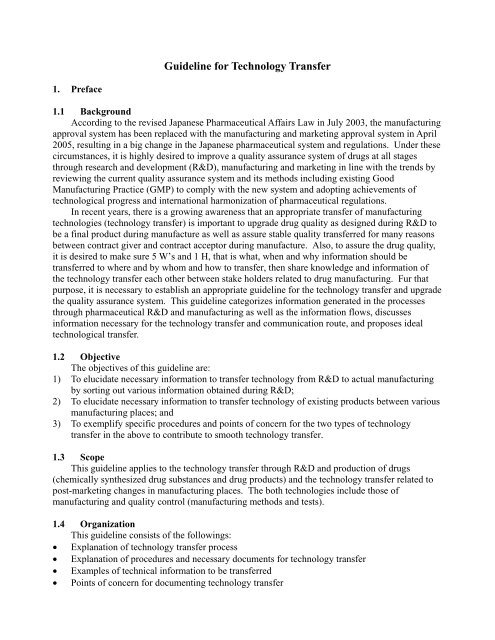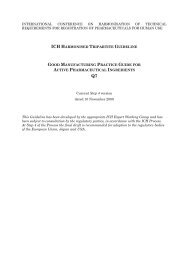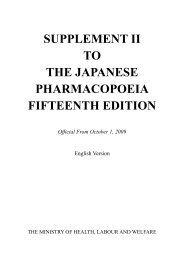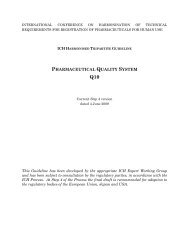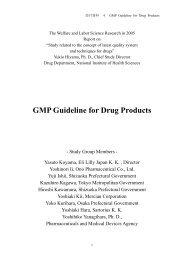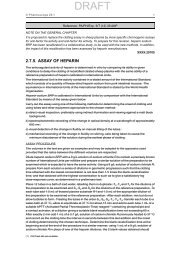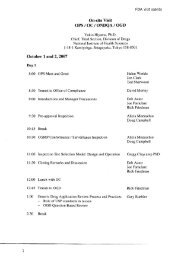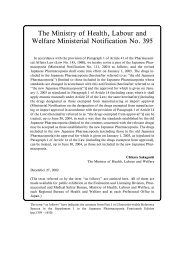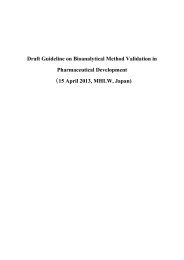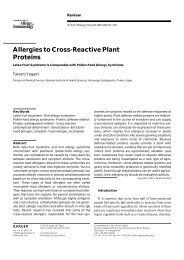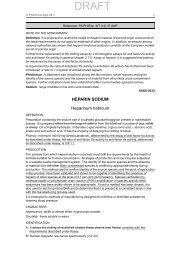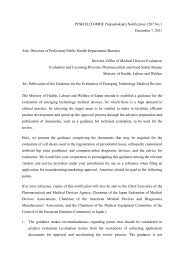Guideline for Technology Transfer (Draft) - NIHS
Guideline for Technology Transfer (Draft) - NIHS
Guideline for Technology Transfer (Draft) - NIHS
You also want an ePaper? Increase the reach of your titles
YUMPU automatically turns print PDFs into web optimized ePapers that Google loves.
<strong>Guideline</strong> <strong>for</strong> <strong>Technology</strong> <strong>Transfer</strong><br />
1. Preface<br />
1.1 Background<br />
According to the revised Japanese Pharmaceutical Affairs Law in July 2003, the manufacturing<br />
approval system has been replaced with the manufacturing and marketing approval system in April<br />
2005, resulting in a big change in the Japanese pharmaceutical system and regulations. Under these<br />
circumstances, it is highly desired to improve a quality assurance system of drugs at all stages<br />
through research and development (R&D), manufacturing and marketing in line with the trends by<br />
reviewing the current quality assurance system and its methods including existing Good<br />
Manufacturing Practice (GMP) to comply with the new system and adopting achievements of<br />
technological progress and international harmonization of pharmaceutical regulations.<br />
In recent years, there is a growing awareness that an appropriate transfer of manufacturing<br />
technologies (technology transfer) is important to upgrade drug quality as designed during R&D to<br />
be a final product during manufacture as well as assure stable quality transferred <strong>for</strong> many reasons<br />
between contract giver and contract acceptor during manufacture. Also, to assure the drug quality,<br />
it is desired to make sure 5 W’s and 1 H, that is what, when and why in<strong>for</strong>mation should be<br />
transferred to where and by whom and how to transfer, then share knowledge and in<strong>for</strong>mation of<br />
the technology transfer each other between stake holders related to drug manufacturing. Fur that<br />
purpose, it is necessary to establish an appropriate guideline <strong>for</strong> the technology transfer and upgrade<br />
the quality assurance system. This guideline categorizes in<strong>for</strong>mation generated in the processes<br />
through pharmaceutical R&D and manufacturing as well as the in<strong>for</strong>mation flows, discusses<br />
in<strong>for</strong>mation necessary <strong>for</strong> the technology transfer and communication route, and proposes ideal<br />
technological transfer.<br />
1.2 Objective<br />
The objectives of this guideline are:<br />
1) To elucidate necessary in<strong>for</strong>mation to transfer technology from R&D to actual manufacturing<br />
by sorting out various in<strong>for</strong>mation obtained during R&D;<br />
2) To elucidate necessary in<strong>for</strong>mation to transfer technology of existing products between various<br />
manufacturing places; and<br />
3) To exemplify specific procedures and points of concern <strong>for</strong> the two types of technology<br />
transfer in the above to contribute to smooth technology transfer.<br />
1.3 Scope<br />
This guideline applies to the technology transfer through R&D and production of drugs<br />
(chemically synthesized drug substances and drug products) and the technology transfer related to<br />
post-marketing changes in manufacturing places. The both technologies include those of<br />
manufacturing and quality control (manufacturing methods and tests).<br />
1.4 Organization<br />
This guideline consists of the followings:<br />
• Explanation of technology transfer process<br />
• Explanation of procedures and necessary documents <strong>for</strong> technology transfer<br />
• Examples of technical in<strong>for</strong>mation to be transferred<br />
• Points of concern <strong>for</strong> documenting technology transfer


